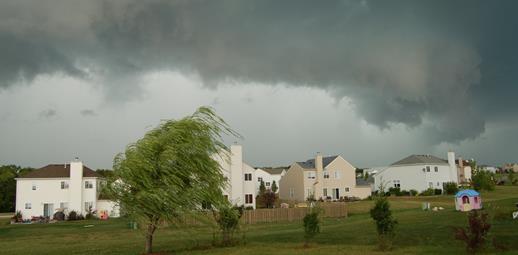
Since storms frequently occur in the UK, it's essential to prepare your home for them. When you're not prepared for strong winds, you risk all kinds of problems from losing roof tiles to potential damage from flying items.
Take these steps to help protect your house from strong winds.
EASY AS HACK
Check the Met Office weather warnings to see if you should protect your home from strong winds:
- Yellow warning – winds reach avg. speed of 30-40mph
- Amber warning – winds reach avg. speed of 40-50mph
- Red warning – winds reach an avg. speed of 50mph+
maintain your roof
You should regularly inspect your roof to ensure it’s robust enough to withstand any strong winds that may come your way. Consider your safety and hire a professional roofer to inspect and repair your home.
Loose, damaged, or missing tiles can lead to issues like dampness if you don’t maintain your roof or inspect it regularly. You may want to consider having your roofer replace and repair the tiles and flashing, as well as examine the ridges, verges, and eaves.
If you have a flat roof, it likely requires more maintenance and repairs compared to a regular pitched roof.[2] You should check your flat roof twice a year and after storms. Also, ensure you clear away leaves, debris and dirt that could block drainage or lead to damage. Discover the key things to look out for with your roof using our comprehensive roof maintenance checklist.
clear your gutters
While you’re checking whether you have prepared the roof for strong winds, clear any gutters of debris.
Guttering clogged with leaves, moss, growing weeds, and flowers is a common issue. You don’t want the gutters to start sagging with the weight and coming away from their brackets in a storm.
If heavy rain accompanies high wind, blocked gutters can overflow and cause problems such as flooding.
park your car safely
It’s not just protecting your home from strong winds that requires some thought. It’s essential to stay safe in severe storms, as high winds can cause trees, walls, and fences to fall.
So, if you have a garage, park your car in it for safety. Otherwise, try to park away from buildings, trees, walls and fences.
You might be worried that a tree in your garden could hit a car in your drive. According to the Royal Horticultural Society, a semi-permeable living windbreak such as a hedge can help to slow wind speeds in exposed gardens. However, it won’t stop the wind entirely.[3]
secure loose items
Sometimes, it’s easy to forget what could be lying about in your garden or outdoor area, if you have one. Check you haven’t left any loose objects that a strong wind could blow into windows, doors or other parts of the building, causing damage.
Be sure to put the following items away or secure them when the weather forecast predicts strong winds:
- Ladders
- Wheelie bins
- Patio furniture
- Flowerpots
- Window boxes
- Lawn decorations
- Trampolines
- Toys
- Parasols
- Bird feeders
- Hanging baskets
- Rotary washing lines
- Barbecues
secure trampolines
Trampolines deserve a special mention. You may have seen the social media images of trampolines blown out of people’s gardens and into some surprising places – including on a railway track during the 2020 Storm Ciara.
Do you have a trampoline? To prevent it from blowing away in strong winds, the safety organisation Rospa has the following advice:
- Store your trampoline safely when not in use, particularly during the winter months when the winds can be stronger.
- Tie down large trampolines. You can buy trampoline tether kits if needed.
- It’s also a good idea to remove the safety netting from trampoline frames, as it can act like a sail during windy weather.
fix fences
Fences are often damaged during high winds, especially if they’re old and weak or have shallow foundations.
So, if you need to, try to get your old fences fixed and potentially reinforced before the winds pick up, as these are one of the most likely areas to be affected.
Fixing fences is particularly important, as most home insurance policies don’t cover damage to them.
check trees
Fallen trees and branches are among the most significant hazards in strong wind.
So, try to keep any trees regularly pruned – you may need a tree surgeon’s help – and consider removing dead, loose or overhanging branches that can be dangerous or cause damage.
Bear in mind that if a Tree Preservation Order (TPO) protects the tree, you’ll need your local planning authority’s permission to perform any management work or remove the tree.[4]
Hedges act as natural windbreaks, but regular trimming will ensure they don’t get too top-heavy. Never cut hedges in the middle of strong winds, as it could endanger you and damage the branches. Inspect and repair any hedges after a strong wind has died away.
close and secure doors and windows
Close and lock your windows and doors, including your garage door if you have one. Make a point of checking the windows and doors on parts of the house most exposed to the wind.
Also, the Met Office advises that homeowners should close and secure loft trapdoors with bolts before strong winds arrive, particularly if their roof pitch is less than 30°.[1]Doing so prevents the wind from howling through gaps and prevents it from coming open unexpectedly, which could cause an accident.
prepare an emergency kit
It’s best to prepare an emergency kit if the forecast indicates strong winds, as they can cause significant disruption. They can lead to electricity outages, damage to your home and property and flooding.
Be prepared for high winds by assembling an emergency kit. The Red Cross[5] advises that it should include the following in a waterproof bag:
- Emergency contact numbers (written on a pad or paper, as mobile phones can run out of charge)
- Mobile phones and chargers
- Insurance policies and other important documents, like passports and birth certificates
- Torches – wind-up or battery-operated, with spare batteries
- Blankets and warm clothing
- First aid kit and essential medicines
- Water and food that’s ready to eat and doesn’t need a fridge
- Spare car and home keys, glasses and contact lenses
- Supplies for babies and pets
check whether your home is at risk of floods
Storms and strong winds often bring with them all sorts of other risks. One is flooding. So, check if your home is at risk of flooding and then move your family, cars, pets and valuables to higher ground, such as an upstairs location.
Here are some steps you can take to minimise flood damage if there’s a risk of flooding and you have time to prepare. Flooding can destroy homes, disrupt lives and livelihoods, and leave people in need of shelter, food, clothing and financial assistance in the immediate aftermath. It can take months to return to normal.
Remember, storms can result in power outages, so put together the emergency kit detailed above, which includes flashlights, necessary medications, food, water, and blankets.
check your building insurance
Even with careful preparation, you can’t always protect your home from nature’s fury.
It’s a good idea to double-check that your building insurance is up to date and covers your needs adequately. Building insurance covers your home’s structure. It typically provides the cost of emergency accommodation should your home be flooded.[6] Please make sure you check your policy booklet for the claim limits relating to this.
The financial consequences can be severe if you let your building insurance lapse, fail to renew, or underinsure your property. You will be responsible for all repair costs and will have no cover for new damage caused by the strong wind if the policy isn’t active when it occurs. You’d also have to pay for your accommodation if your home is uninhabitable.
If you need to make a claim for your buildings and your sum insured isn’t enough to rebuild your property, it’s not simply the case that you would automatically receive up to the maximum amount of your buildings sum insured. Therefore, you must ensure that your building insurance is sufficient to cover the entire cost of a rebuild. Even if your policy is active, your payment may not be enough to cover all repairs or rebuilding if you are underinsured.
Make sure you have the correct insurance cover:
- Read your policy carefully and understand what is covered and excluded, as well as any excesses, exclusions and limits
- Check whether your policy provides alternative accommodation should the house need repairs
- Check the sum insured and re-evaluate your home’s rebuilding costs regularly – consider registering for the Building Costs Information Service for the general costs of rebuilding
- Note your insurance renewal date several weeks in advance so you have time to shop around.[7] If you auto-renew, you can sometimes pay more than you need, so it can pay to shop around beforehand
- Compare the cover, as well as the price[8]
- Review your cover if you’ve added an extension or other improvements, then update your insurer[9]
- Contact your insurer if you have any worries and update them on any changes.
Prevention is better than a cure – keep your property maintained to avoid having to make a claim and to reduce the distress.[8]
- Sign up for the Environment Agency’s flood alert service to make your home more resilient
- Check whether your insurer has signed up to the Build Back Better (BBB) scheme, which offers property flood resilience measures after a flood.
Discover how Ageas offers Build Back Better to eligible customers whose flood event occurred after 1 June 2022 and whose property has flooded previously.
WHAT SHOULD YOU DO DURING STRONG WINDS?
These are the best ways to keep safe in your home during strong winds:
- Stay indoors where possible, away from windows, skylights and doors
- Shut all windows and doors
- At home, stay downstairs or in the basement if possible
- If you go outside, try to avoid walking near buildings, trees or fences, which could fall and collapse, and downed power lines
- Do not attempt to make any repairs while the storm is at its height
- Open internal doors only as needed and close them behind you
WHAT SHOULD YOU DO if your home has been damaged?
Inspect your home for damage once any strong winds have died down and the storm has passed.
- Don’t touch any downed power or telephone cables that the wind has blown down
- Be careful walking near walls, buildings and trees that the winds may have weakened
- Report a fallen tree to your local authority – find your local council
- Report an insurance claim as soon as possible – many insurers have 24-hour emergency helplines [7]
- Check with your insurer before arranging repair work
- Get receipts for any emergency repairs you have to make
- Get as much photographic evidence and samples as you can
- Don’t throw out damaged goods unless they are hazardous
Protect your home from strong winds by taking out comprehensive buildings insurance cover like ours.
Find out more about our home insurance.
FAQs
does home insurance cover wind damage?
Most standard home insurance policies cover wind damage as part of storm damage, but what’s included will depend on your specific policy. You should read your policy to check on your insurer’s definition of ‘storm’ and whether exclusions and limitations apply.
what is the safest place in your house during strong winds?
Interior rooms with strong structural supports, like bathrooms, halls and cellars, are likely to be the safest places in your house during strong winds. However, do not use a basement if your home is at risk of flooding. Stay away from windows and exterior walls that could collapse.[1]
what should you do if a window breaks during a storm?
You should not try to clean up broken glass if a window breaks during a storm. The safest option is to move into a different room while it rages. Don’t repair the damage until the winds let up.[1]Afterwards, arrange for repairs and keep any receipts for your insurance company. In the meantime, you can cover the broken window from inside the house with thick plastic, card or tarpaulin.
Sources
[1] https://weather.metoffice.gov.uk/warnings-and-advice/seasonal-advice/your-home/stay-safe-in-a-storm
[2] https://www.ricsfirms.com/residential/moving-home/buying/flat-roofs-pros-cons/
[3] https://www.rhs.org.uk/plants/types/hedges/windbreaks-shelterbelts
[5] https://www.redcross.org.uk/get-help/prepare-for-emergencies/prepare-an-emergency-kit
[9] https://www.citizensadvice.org.uk/consumer/insurance/types-of-insurance/buildings-insurance/


